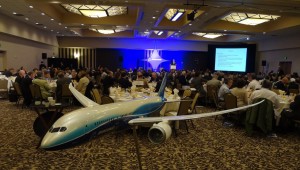Commentary by Hal Calbom of Sustainable Media.
 Both our large research universities are grappling with ways to address the chaotic, multi-dimensional and strange-bedfellows world that is clean technology.
Both our large research universities are grappling with ways to address the chaotic, multi-dimensional and strange-bedfellows world that is clean technology.
The highlight of the first annual WCTA breakfast Thursday morning was a 45-minute session with the presidents of our two great research universities–Michael K. Young of the University of Washington and Elson S. Floyd of Washington State University–facilitated by McKinstry’s Ash Awad.
And they’re trying to defy dated stereotypes of the past: That the University of Washington’s research colossus isn’t nimble enough to pivot toward new, innovative opportunities and commercialize them quickly; and that Washington State University, despite its land-grant roots in infrastructure, new materials, power generation and bio-sciences, can’t mainstream its innovations from faraway Pullman.
Show Me the Money. With the obligatory “we have an astonishing array of programs” introductory remarks out of the way, it became obvious that the UW and WSU don’t just advocate innovation and commercialization, they require it. It comes down to money.
Not just getting more innovation money: it’s making up for what’s been slashed from their respective operating budgets, too. Unprecedented budget cuts require Floyd and Young not only to do much more with much, much less, but also to cultivate the private sector even to supplement their ongoing operations.
Hence innovation and commercialization — usually regarded as the “practical” counterpart to traditional pure research — will more and more be relied upon to fund both technology transfer and business as usual. That’s a major walk across the street. Or, as Michael Young dubbed it, “a major shift in the way we engage the world.”
Ivory Tower Retailing. “Commercialization will fuel the economy,” forecasts Floyd, suggesting that as the Universities have been victims of the recession, they may also play a much greater role breaking us out of it. Look for “contract research with well-defined deliverables” replacing the more aimless, “Gee this looks good maybe we can make a product out of it” approach that we usually associate with university commercialization efforts.
Both Floyd and Young encourage clean tech entrepreneurs to “take a professor to lunch” and break down barriers. “We’re looking for catalyst dollars from the public / private sector and quicker decisions about the value of our Intellectual Property,” adds Floyd, though Young insists that “basic research will always be critical to the mission of both universities.”
The Inevitable Sports Metaphors. When UW and WSU meet in any arena, there’s talk of competition (though one of the benign effects of cleantech research is that power, fuel and efficiency are so systems-centric and integrative that they’re natural silo busters, tending to create teamwork across the state and across school color lines).
Still, given WSU’s substantial head start — they’ve had their hands in the soil and their fingers on the power switches a lot longer than the UW — I’d rate today’s clean tech commercialization / innovation score as 20 – 7 Cougars, late in the second quarter.
But watch out: University of Utah spun out more companies than any university in the country during Michael Young’s tenure there. The new guy in Montlake has a run and shoot offense, a strong arm, and looks to light up the scoreboard in the second half.
And that should benefit both the purple and gold and crimson and gray.